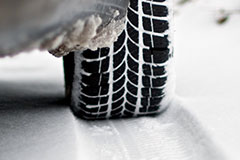Differences between Summer Tires and Snow Tires - Vol.347
Summer tires and snow tires sound about as different as fire and ice, but can they be so different? After all, they're just tires made of rubber and additives.

Let's cut to the chase before getting into the nitty gritty. Summer tires are marketed as performance or high performance tires nowadays. They are designed for the best traction on dry and wet roads ? but only when it's warm or hot out. Summer tires are not only unsuitable for snowy roads, they are downright unsafe. You would have to possess a certain amount of driving experience, maybe even the right driving skills, to not have the car become disabled while driving with summer tires on snowy roads. For example, you have to put just the right amount of pressure on the gas pedal from a stop or the vehicle will mostly likely wobble. You have to know how to brake properly or the vehicle will skid. If you have a rear-wheel drive, you are even more likely to get your tire stuck on an unplowed or hastily plowed road.
Almost all sports cars and sporty luxury cars today are sold with high performance or summer tires. In the cold season you have a choice of putting the car away, or drive carefully and only for short distances, or better yet, swap in a quad of snow tires.
Snow tires are designed specifically to handle cold weather and snowy road conditions. The roadcontact or thread part of tires is made of rubber compounded with different petroleum byproducts. The thread part has to be soft and pliable in order to grip the road. As we know, liquids get thicker and solids get harder as the temperature drops. The threads of summer tires, designed for warmer weather, would growso hard in cold weather (approximately 7 degrees Celsius and below) as to become a shadow of their formerly formidable road-gripping prowess.
In contrast, the threads of snow tires are in their element in cold weather. There's a term used by scientists and engineers called glass transition temperature. This is the temperature at or below which the molecules of polymers such as rubber compounds become constraint in their movements, the result of which is the transition of the rubber compound from rubbery road-gripping material to hard glasslike substance. Sincethe rubbery road-gripping threads of summer tires are optimized for warmer weather, they can only become overly hard and lose traction in cold weather. In snowy conditions, a car with summer tires can take twice as long to cover 100ft and more than double the distance to brake than the same car riding on snow tires.
The glass transition temperature of snow tires is way below freezing temperature. The flip side of such a design is that the threads of snow tires would become too soft in hot weather. It doesn't mean that snow tires cannot be used in the summer. With snow tires, you won't be able to cut corners as confidently in hot weather as with high performance summer tires. Moreover, the softer threads of snow tires will wear out very quickly in hot weather.
The other reason why snow tires ride so much better in snow is the design of the threads. Summer tires have blocky threads with deep grooves aimed at dislodging water. Snow is much harder to dislodge so the designers of snow tires don't worry too much about that. Rather, they rely on a technique called siping, which involves cutting sipes or very thin slits all over the road-contact surface of a snow tire. This in effect creates more threads with which to grip snowy roads.
Siping was named in honor of the man who invented it in 1923, John F. Sipe. Almost a century later today, let's not play with hazard and always put on snow tires for the cold season. Investing in two sets of tires is like investing in two sets of shoes. They will last approximately twice as long because you can only put on one set at a time, so why not?